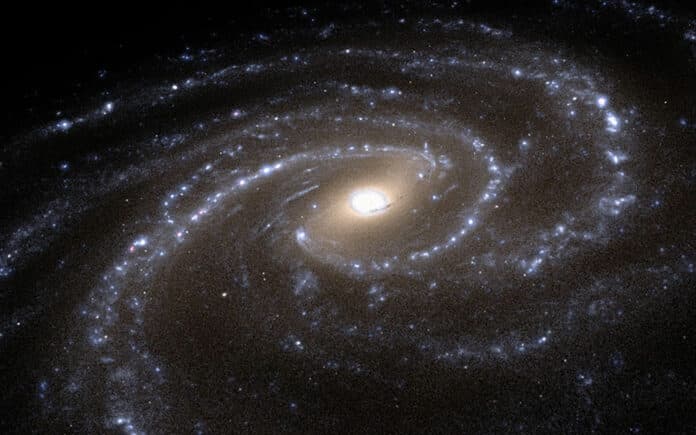Milky Way is a disk galaxy with a straight bar in the middle connecting the spirals. The inner part of the bar has a peanut-shaped bulge, where the bar is thicker, sticking out above and below the mid plane of the Milky Way galaxy, and a nuclear bulge, which is disk-like and located in the central part of the Milky Way. Some barred galaxies, but not all, exhibit similar two-type bulges.
Previous studies suggested that the boxy/peanut/x-shaped bulge can either be developed by bar buckling or vertical inner Lindblad resonance (vILR) heating without buckling. In a new study, a team led by Junichi Baba at the National Astronomical Observatory of Japan (NAOJ) simulated one possible scenario for a Milky-Way-like galaxy.
They conducted a simulation on the world’s most powerful supercomputer called ‘ATERUI II’ at NAOJ. The simulation is the most complete and precise to date, which includes the stars in the galaxy, interstellar gas, the birth of new stars from the gas, and the deaths of stars as supernovae.
The formation of a bar allows the flow of gas into the galaxy’s center, where it sparks the birth of new stars. Therefore, it may be plausible to suppose that the galaxy’s nuclear bulge is made of newly formed stars.
But because the bar is so good at driving gas towards the center, simulations suggest that there are hardly any new stars in the bar outside the nuclear bulge. This proves that a peanut-shaped bulge in the bar does not form due to gorging on gas. The team discovered that some stars could be propelled into orbits that carry them above and below the mid-plane by gravitational interactions.
The simulation’s ability to create a testable scenario is its most fascinating feature. All the stars in the peanut-shaped bulge must have formed before the bar because it doesn’t pick up any new stars. The bar also directs the gas into the center, where it forms many young stars. The nuclear bulge’s stars will have given birth nearly exclusively after the bar developed. This implies that there will be a distinct age difference between the stars in the nuclear bulge and the stars in the peanut-shaped bulge. The moment of this break is when the bar first appears.
Data from the European Space Agency’s Gaia probe and Japan’s future JASMINE satellite will allow us to determine the motions and ages of the stars and test this scenario. If astronomers can detect a difference between the ages of the stars in peanut-shaped and nuclear bulges, it will not only prove that overeating is not to blame for the peanut-shaped bulge, it will tell us the age of the bar in the Milky Way galaxy.
Journal Reference:
- Junichi Baba et al., Age distribution of stars in boxy/peanut/X-shaped bulges formed without bar buckling, Monthly Notices of the Royal Astronomical Society (2022). DOI: 10.1093/mnras/stac598
